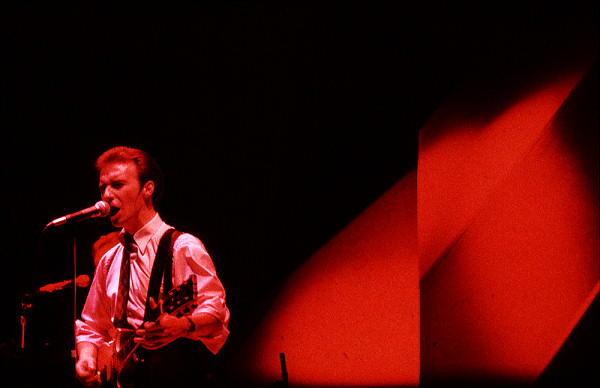Quartet was Ultravox’s sixth overall studio LP and the third to feature the classic line-up of Midge Ure (lead vocals & guitar), Chris Cross (bass), Billy Currie (keyboards & violin), and Warren Cann (drums). The album yielded four U.K. top-20 singles ("Reap the Wild Wind," "Hymn," "Visions in Blue," and "We Came to Dance") and ultimately peaked at #6 on the British album charts.
Whereas the prior two albums – 1980’s Vienna and 1981’s Rage In Eden – were produced & engineered by Conny Plank (Kraftwerk, Devo, Eurythmics), for Quartet the band instead enlisted The Beatles’ dream team of producer George Martin and engineer Geoff Emerick. Fan continue to debate this unusual choice of producer today, with Martin’s involvement definitely resulting in a notable sonic difference from what came before.
Every version of Quartet that I’ve heard – from the 1982 U.K. LP to the 2009 remaster currently available on streaming services – sounds rather flat and unexciting, with a real lack of energy at both the high and low ends of the EQ spectrum. It’s a shame as the more-energetic rock songs on the album like “When The Scream Subsides” and “Cut & Run” would surely have benefited from an injection of ‘punch’ and immediacy, which is exactly what Steven Wilson has delivered in his transformative stereo & 5.1 remixes.

Right from the first bass note of “Reap The Wild Wind,” it’s clear that this fresh new perspective is exactly how the album always should have sounded. The rhythm section is finally given some real weight in Wilson’s mix and it sounds absolutely thunderous, particularly in 5.1 surround where the tom-tom rolls stretch out into the rear speakers.
As with his excellent work on Vienna and Rage In Eden, the 5.1 mix makes extensive use of the rear speakers for isolated synthesizers, guitars, and harmony vocals. There are even some fun passages where elements move around the room, such as the intro to “Serenade” and breakdown of “We Came To Dance.”
“Reap The Wild Wind” kicks into gear with the background vocal chorus mixed entirely to the back of the room, while Midge Ure’s centered lead vocal alternates with rear channel chants of “take my hand.” Double-tracked vocals and piano pop up from behind for "Serenade," with “Hymn” again showcasing a steady diet of synthesizers and percussion in the rear speakers.

“Visions In Blue” somehow becomes even more dramatic in 5.1 surround, thanks to the enhanced dynamic range and supercharged low-end response in the remix. Ure’s lead vocal is again forcefully isolated in the center channel, with the background vocals (“only for you”) and ominous synthesizers placed in the rears. For the faster section, sequencers move all around the room while the chorus vocal chants emanate completely from behind.
Background vocals (“and we talked…”) alternate front-and-rear for the chorus of “When The Scream Subsides,” while Ure’s guitar and Currie’s synths again battle front-to-back. The synthesizer solo midway through emanates almost entirely from the center channel, giving way to Cann’s tom-toms thundering in the left rear speaker.
Midge Ure’s rhythm guitar rips through the front left channel in “Cut & Run,” while Currie’s synth pops up from directly behind. For the song’s coda, the chorus vocals (“see the man on the phone…”) alternate between the center and rear speakers. The album proper then ends with “The Song (We Go),” again featuring some furious all-channel percussion interplay.
In addition to the ten-track main album, Wilson has also remixed Quartet’s three instrumental B-sides (“Hosanna (In Excelsis Deo),” “Break Your Back,” and “Monument”) in stereo & 5.1 surround sound. The immersive effect in the B-sides is arguably even more impressive than the album tracks, given the more experimental nature of these songs. “Break Your Back” is truly insane in surround sound, with the drum, synth, and vocal samples wildly alternating from all four corners of the listening space.
Overall, I’d argue that the new mix – especially the 5.1 presentation – is a monumental sonic upgrade over the 1982 original, perhaps on par with James Guthrie’s 2018 remix of Pink Floyd’s Animals or Wilson’s own 2011 reworking of Jethro Tull’s Aqualung. It’s honestly hard to believe that this music was put to tape more than four decades ago.
All that being said – If Wilson’s fresh take on the album doesn’t work for you, rest assured that the 1982 Martin/Emerick stereo mix is presented alongside it on the DVD as a new 96-khz/24-bit remaster from the original two-track master tape. I think it’s a considerable improvement over the 2009 remaster, which is the only other version of the album carried by the streaming services.

Though the DVD is likely the crown jewel of the set for immersive music fans and audiophiles, the set also includes the band’s October 1982 live performance at the Hammersmith Odeon – newly remixed by Richard Whittaker – across two CDs.
It’s my hope that Steven Wilson sticks around to remix the band’s 1984 follow-up Lament, featuring two of my personal favorite Ultravox songs (“White China” and “Lament”). Until then, given the limited availability of these 40th anniversary reissues – the Vienna 5CD/DVD set is already becoming scarce – don’t hesitate to pick up a copy!
Support IAA by purchasing the Quartet 6CD/DVD Deluxe Edition via this link!

